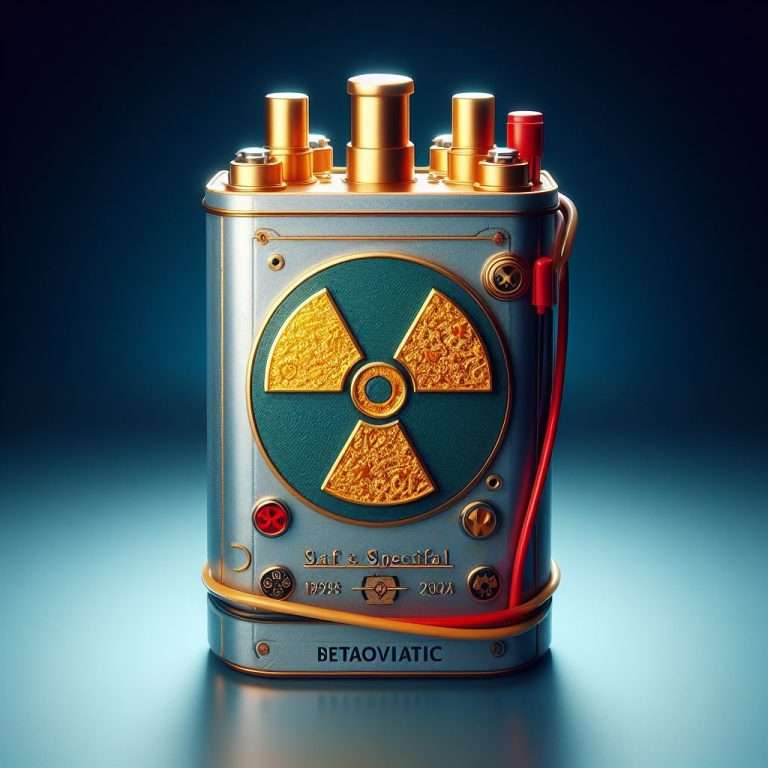Technical Specifications of Betavolt
Technical Specifications of Betavolt: Betavoltaic batteries, with their extended lifespans and minimal maintenance requirements, boast a unique set of technical specifications that set them apart from conventional batteries. Let’s delve deeper into these specifications, exploring the intricacies behind each parameter and the ongoing advancements shaping their future.
Table of Contents
Technical Specifications of Betavolt

1. Isotope Selection: The Powerhouse Within
The type of radioactive isotope used in a betavoltaic battery significantly influences its performance. A popular choice is Tritium (³H), a radioactive isotope of Hydrogen. Tritium offers several advantages:
- Low-Energy Beta Emissions: Tritium’s beta particles carry a relatively low amount of energy. This is crucial for safety, as it allows for effective shielding within the battery using minimal materials.
- Favorable Half-Life: Tritium boasts a half-life exceeding 12 years. This translates to a gradual decay of the isotope over time, ensuring the battery can provide a continuous, albeit low, power output for decades.
However, researchers are actively exploring alternative isotopes:
- Higher Energy Emitters: Certain isotopes like Nickel-63 (⁶³Ni) emit beta particles with higher energy compared to Tritium. While requiring more robust shielding, this could potentially lead to increased power output from the battery.
- Longer Half-Life Options: Isotopes with even longer half-lives, like Promethium-147 (¹⁴⁷Pm), are being investigated. This could extend the operational lifespan of betavoltaic batteries even further.
2. Semiconductor Material: The Conversion Engine
The choice of semiconductor material plays a critical role in converting the energy of beta particles into usable electricity. Here are some key considerations:
- Bandgap: The bandgap refers to the energy difference between the valence band (where electrons reside) and the conduction band (where electrons can move freely). A material with a bandgap that aligns well with the energy of the beta particles allows for efficient conversion of their energy into electron-hole pairs.
- Carrier Mobility: This parameter reflects how easily electrons and holes can move within the semiconductor material. Higher carrier mobility translates to a more efficient flow of current within the battery.
- Radiation Tolerance: Betavoltaic batteries are constantly exposed to radiation from the decaying isotope. The chosen semiconductor material needs to be resistant to this radiation damage to maintain its performance over the long term.
Commonly used semiconductor materials in betavoltaics include:
- Diamond: Offering a wide bandgap and exceptional radiation tolerance, diamond is a promising candidate. However, its high production cost remains a challenge.
- Silicon Carbide (SiC): SiC offers a good balance between bandgap, carrier mobility, and radiation tolerance, making it a popular choice for current betavoltaic battery models.
- Gallium Nitride (GaN): GaN possesses a wider bandgap compared to SiC, potentially allowing for more efficient conversion of higher-energy beta particles from alternative isotopes.
3. Unveiling the Power Parameters: A Balancing Act
The power output of a betavoltaic battery is a crucial specification determining its applicability. Here’s a breakdown of some key parameters:
- Open-Circuit Voltage (Voc): This represents the maximum voltage a betavoltaic battery can produce when no current is flowing (open circuit). Typical values range from 0.3V to 3V, depending on the design, materials used, and the number of cells connected in series.
- Short-Circuit Current (Isc): This reflects the maximum current a betavoltaic battery can deliver when its terminals are directly shorted (connected together). Current models typically exhibit Isc values in the nanoampere (nA) to microampere (µA) range.
- Fill Factor (FF): This parameter indicates how well the real-world operating voltage and current of the battery approach the ideal values represented by Voc and Isc. A higher FF signifies a more efficient conversion of power within the battery.
- Efficiency: This metric reflects the effectiveness of the battery in converting the energy of beta decay into usable electricity. Current betavoltaic batteries have efficiencies ranging from a few percent to around 8%. Researchers are actively exploring ways to improve efficiency by optimizing materials, design, and fabrication processes.
4. The Lifespan Advantage: A Long-Lasting Power Source
One of the most captivating features of betavoltaic batteries is their extraordinary longevity. This stems from the nature of the radioactive decay process:
- Half-Life: As mentioned earlier, the isotope’s half-life plays a critical role. Over this period, half of the isotope nuclei will decay, with the remaining half continuing to decay at a constant rate.
- Gradual Power Reduction: As the isotope decays over time, the number of beta particles emitted and the resulting
- power output of the battery gradually decrease. However, due to the long half-lives of isotopes like Tritium (over 12 years), this decrease is slow, allowing the battery to function for decades.
5. The Evolving Landscape: Pushing the Boundaries
- Betavoltaic technology is still in its early stages, but significant advancements are paving the way for a more promising future. Here are some exciting areas of research and development:
- Improved Efficiency: Researchers are exploring new materials and design strategies to increase the efficiency of betavoltaic batteries. Optimizing the bandgap of the semiconductor and minimizing internal resistance are key areas of focus. This could significantly increase the power output for a given isotope and open doors to new applications.
- Power Density Boost: Current betavoltaic batteries generate low power, typically measured in microwatts. Research efforts aim to improve power density by exploring higher-energy beta emitters and developing advanced device architectures. This could pave the way for betavoltaic batteries to power low-power sensors and microelectronics in remote locations.
- Advanced Manufacturing Techniques: Developing cost-effective and scalable manufacturing processes is crucial for bringing down the production cost of betavoltaic batteries. This would make them more commercially viable and accessible for a wider range of applications.
Q&A:
What are the specs of the betavolt battery?
Betavoltaic battery specs include the type of isotope used (e.g., Tritium), semiconductor material (e.g., diamond), power output (microwatts currently), open-circuit voltage (0.3V to 3V), short-circuit current (nA to µA), efficiency (a few percent to 8%), and lifespan (decades, based on isotope half-life).
What is the new battery technology in Betavolt?
The “new” aspect of Betavolt isn’t a specific battery, but the ongoing advancements in betavoltaic technology as a whole. Research focuses on improving efficiency, power output, and exploring alternative isotopes and materials.
What is China’s Betavolt new energy technology?
China is actively involved in developing betavoltaic technology. Companies like City Labs are at the forefront of manufacturing these batteries. However, betavoltaic technology is a global field of research, not specific to China.
What is the betavoltaic technology?
Betavoltaic technology harnesses the energy released during radioactive decay of certain isotopes (like Tritium) to generate a small but continuous electric current. Beta particles collide with atoms in a semiconductor material, creating electron-hole pairs that lead to a small electric current.
Conclusion
Betavoltaic batteries offer a unique blend of long lifespan, low maintenance requirements, and inherent safety due to low-energy emissions. While still under development, advancements in efficiency, power density, and manufacturing techniques are shaping a brighter future for this technology. From powering remote sensors in harsh environments to providing a reliable source of energy for medical implants, betavoltaic batteries hold immense potential to revolutionize various industries and contribute to a more sustainable future.
Also Read:
Betavolt’s Nuclear Battery: A Revolutionary Power Source for the Future






